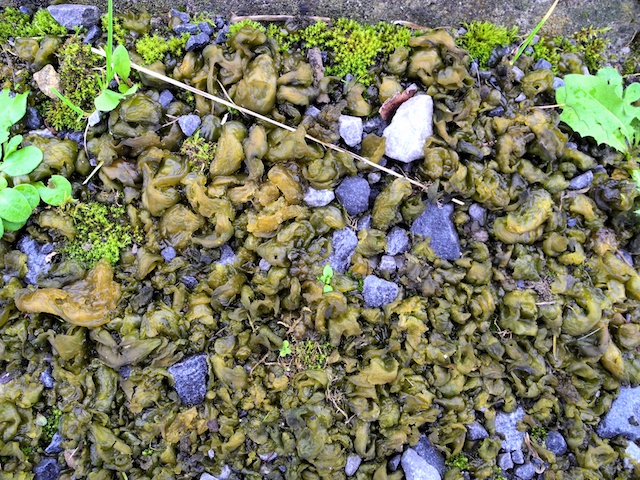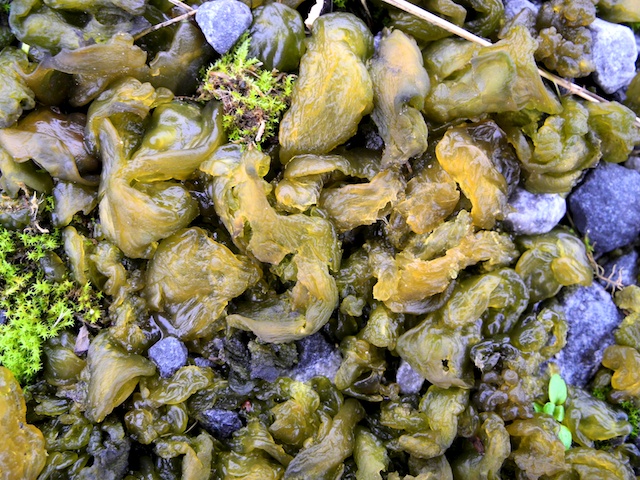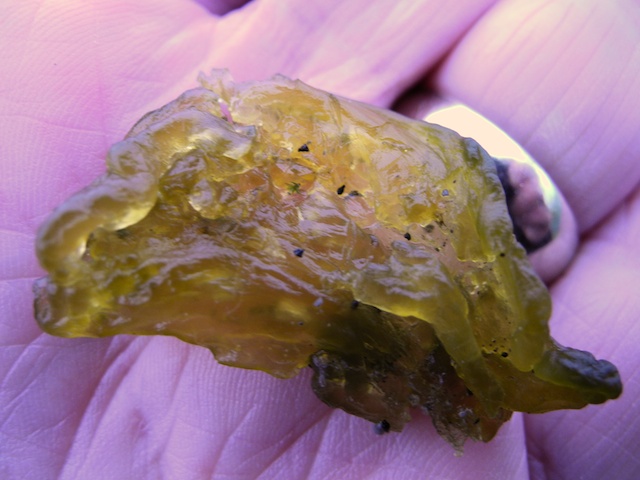Witches' Butter: a nuisance on paths and gardens
Nostoc commune is a terrestrial species regarded as a "form species" (Wright et al. 2001), meaning that a number of indistinguishable species are involved. It is a blue-green alga that occurs worldwide, and is particularly associated with limestone, coral and other calcium-carbonate-based rocks. It can be a nuisance on limestone chippings, limestone or coral paving, and is often mistaken for a seaweed.

These jelly-like masses, often irregularly ear-shaped (photographs above and below from the grounds of NUI Galway, October 30, 2011), appear from time to time in paths, parks, fields, and gardens. They areparticulalry common on limestone gravel near path edgings (above and below), particularly in autumn. It can suddenly appear after rain, seemingly from nowhere, on paths, on roofs and sometimes in poorly-growing lawns. This gave rise to an early belief that it was material from shooting stars that had fallen to earth, hence some of the English common names Fallen Star, Star Jelly and Witches' Butter:
Swift as the shooting star, that gilds the night
With rapid transient Blaze, she runs, she flies;
Sudden she stops nor longer can endure
The painful course, but drooping sinks away,
And like that falling Meteor, there she lyes
A jelly cold on earth.
William Somervile, 1740 The Talisman

When dry they are unsightly, often being mistaken for dried dog faeces, and when wet they can be rather slippery. The bead-like form can be swept up and the rubbery sheets are easily lifted. The loose jelly can be swept up as well. On hard surfaces bleach or a similar cleaner should kill any that remains. Improved drainage, and increased fertility (particularly N and P based fertilizers) will discourage its growth. Michael Viney in the Irish Times advised: "Apply a chlorothalonil- or mancozeb-based fungicide to the infested area once every seven to 14 days until the nostoc is dead."
Growths also occur on limestone chippings used as ballast on flat roofs, particularly on school and university buildings in Britain and Ireland. In damp places, granite chippings should be preferred to limestone.

Nostoc commune seems particularly associated with limestone: populations are found on limestone pavement in the Burren, Co. Clare, Ireland; Malham Tarn in Yorkshire; and on karst (kras) in Slovenia (Potts 2000), where it is thought to play an important part in weathering of the rock surfaces.
Margaret Ibbs writes (July 2016):
" I have read your article as I have been troubled with this Nostoc Commune on my limestone driveway but I believe I have found a cheap and safe cure.
I mixed 1 kg Dri-Pak soda crystals [washing soda, sodium carbonate] with hot water in 10 ltr watering can and when dissolved filled can with cold water, then using a fine rose I sprayed approximately 7 sq yds per can. I repeated this about 2 weeks later.
My driveway is completely clear and has been for 5 months.
I have found that most people that have been troubled with it have used Roundup, I don't know if this is a coincidence.
I posted this on Gardeners World and 3 people so far have thanked me as it worked for them."
Links
http://www.dgsgardening.btinternet.co.uk/bluegreenalgae.htm
Potts, M. (2000), Nostoc. In: Whitton, B.A. & Potts, M. [Eds]. The ecology of Cyanobacteria: their diversity in time and space. pp. i-xviii, 1-673. Dordrecht: Kluwer Academic Publishers.
Wright, D., Prickett, T., Heim, R.F. & Potts, M. (2001). Form species Nostoc commune (Cyanobacteria). International Journal of Systematic and Evolutionary Microbiology 51: 1839-1852.





